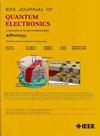基于azo的工程混合等离子波导的增强光调制:高消光比和低电压工作
IF 2.2
3区 工程技术
Q3 ENGINEERING, ELECTRICAL & ELECTRONIC
引用次数: 0
摘要
在这项研究中,我们提出了一种高消光比、低电压、宽光带宽的光调制器,该调制器采用掺铝氧化锌(AZO)的工程混合等离子体波导(HPW)。在HPW中加入薄的AZO层可以实现垂直和横向等离子体模式约束。通过在AZO中诱导载流子变化,我们实现了epsilon-near-zero (ENZ)状态,促进了在1500 nm至1650nm波长范围内的有效强度和相位调制。优化的器件几何结构确保了介质波导模式和表面等离子体模式之间的电光耦合,与传统hpw相比,损耗更低。在1 V的低电压下,消光比(ER)范围为13 dB/ $\mu $ m至45 dB/ $\mu $ m,在1500 nm至1650 nm波长范围内,调制效率范围为2.75 V- $\mu $ m至2.90 V- $\mu $ m。我们与另一种流行的ENZ材料铟锡氧化物(ITO)进行了比较分析,表明基于azo的调制器具有高载流子迁移率,优于基于ITO的调制器。AZO作为ENZ材料,由于其独特的电光特性和与hpw的兼容性,具有光调制的变革潜力,为高速,高效和紧凑的光调制器提供了显着优势。我们提出的调制方案将在推进光通信、量子计算和量子传感技术方面发挥关键作用。本文章由计算机程序翻译,如有差异,请以英文原文为准。
Enhanced Optical Modulation in AZO-Based Engineered Hybrid Plasmonic Waveguide: High Extinction Ratio and Low Voltage Operation
In this study, we propose a high-extinction-ratio, low-voltage optical modulator with wide optical bandwidth operation in an engineered Hybrid Plasmonic Waveguide (HPW) utilizing Aluminum-doped Zinc Oxide (AZO). Incorporating a thin AZO layer into the HPW enables vertical and lateral plasmonic mode confinement. By inducing carrier changes electrically in AZO, we achieve the epsilon-near-zero (ENZ) state, facilitating efficient intensity and phase modulation across a wavelength range of 1500 nm to 1650nm. Optimized device geometry ensures proficient electro-optic coupling between the dielectric waveguide mode and the surface plasmon mode, resulting in lower losses compared to conventional HPWs. The extinction ratio (ER) ranges from 13 dB/ $\mu $ m to 45 dB/ $\mu $ m at a low voltage of 1 V, with modulation efficiency spanning from 2.75 V- $\mu $ m to 2.90 V- $\mu $ m for wavelengths between 1500 nm and 1650 nm. We conduct a comparative analysis with another popular ENZ material, Indium Tin Oxide (ITO), demonstrating that the AZO-based modulator, with its high carrier mobility, outperforms the ITO-based modulator. AZO, as an ENZ material, holds transformative potential for optical modulation due to its unique electro-optical properties and compatibility with HPWs, offering significant advantages for high-speed, efficient, and compact optical modulators. Our proposed modulation scheme is poised to play a crucial role in advancing optical communication, quantum computing, and quantum sensing technologies.
求助全文
通过发布文献求助,成功后即可免费获取论文全文。
去求助
来源期刊

IEEE Journal of Quantum Electronics
工程技术-工程:电子与电气
CiteScore
4.70
自引率
4.00%
发文量
99
审稿时长
3.0 months
期刊介绍:
The IEEE Journal of Quantum Electronics is dedicated to the publication of manuscripts reporting novel experimental or theoretical results in the broad field of the science and technology of quantum electronics. The Journal comprises original contributions, both regular papers and letters, describing significant advances in the understanding of quantum electronics phenomena or the demonstration of new devices, systems, or applications. Manuscripts reporting new developments in systems and applications must emphasize quantum electronics principles or devices. The scope of JQE encompasses the generation, propagation, detection, and application of coherent electromagnetic radiation having wavelengths below one millimeter (i.e., in the submillimeter, infrared, visible, ultraviolet, etc., regions). Whether the focus of a manuscript is a quantum-electronic device or phenomenon, the critical factor in the editorial review of a manuscript is the potential impact of the results presented on continuing research in the field or on advancing the technological base of quantum electronics.
 求助内容:
求助内容: 应助结果提醒方式:
应助结果提醒方式:


